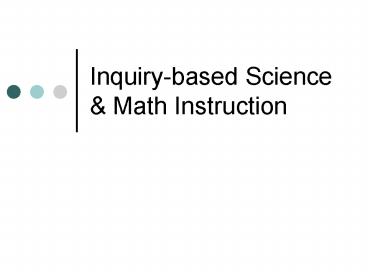Inquiry-based Science - PowerPoint PPT Presentation
1 / 8
Title:
Inquiry-based Science
Description:
Inquiry-based Science & Math Instruction Review What is inquiry? What are the kinds of things that we expect students to be doing in an inquiry-based approach? – PowerPoint PPT presentation
Number of Views:108
Avg rating:3.0/5.0
Title: Inquiry-based Science
1
Inquiry-based Science Math Instruction
2
Review
- What is inquiry?
- What are the kinds of things that we expect
students to be doing in an inquiry-based
approach? - What are the points along the inquiry continuum?
3
Inquiry Continuum
- Confirmation Labs
- Directed Inquiry
- Confirmation Inquiry
- Open Inquiry
4
Simplifying Inquiry Instruction Article
- According to the authors, what are the key
features of inquiry-based instruction? - What is the authors take on internet or library
research (in terms of inquiry)? - Based on the authors framework, provide an
example of a common science/math ed activity - Inquiry
- Non-inquiry
5
Multiple ways of classifying a lesson
- Student centered v. Teacher centered
- Bell et al.s focus on questions data
- Inquiry continuum Confirmation Directed/Guided
Open
6
Figure 1 Activity Series
- 2A)
- Student Centered-No
- Bells Inquiry-No
- Inquiry Continuum-N/A
- 2a) Teacher defines describes the El Nino
effect by using text and images found on the
internet. - 2b) Students go to the library to find newspaper
accounts describing the impact of El Nino on the
California coast. They then summarize what they
find in a two-page written report. - 2c) Students select a location in the US then
search the Internet for monthly temperature data
for this location for the most recent El Nino
year to the average temperature data for the past
50 years in order to assess the impact of El Nino
on that particular location.
- 2B)
- Student Centered-Yes
- Bells Inquiry-No
- Inquiry Continuum-N/A
- 2c)
- Student Centered-Yes
- Bells Inquiry-Yes
- Inquiry Continuum- Guided/Directed
7
Group Task
- Small groups Develop an activity sequence (at
least 3 variations of the same activity). Each of
the variations should be classified differently
based on the 3 taxonomies. - Individuals will partner with a person from
another group. The partners will classify each
others work.
8
Why Classify?
- Do all learning activities need to be
student-centered, focused on student
collection/analysis of data, and moving toward
higher levels of inquiry? NO!!! - These taxonomies can help us think about how we
structure learning experiences and promote
diversity in learning experiences.































